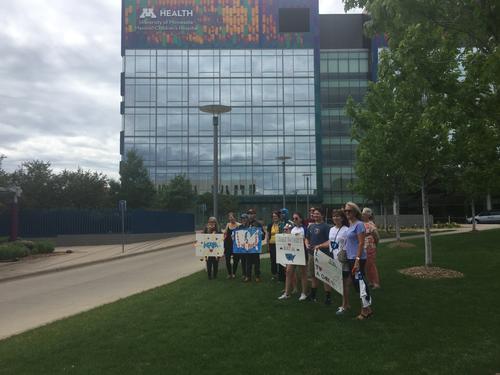Almost two decades later, doctor reflects on using embryo selection to save young girl’s life

Molly Nash was not expected to live to the age of 10. But her parents, and John Wagner, M.D., professor with the Department of Pediatrics in the Medical School, refused to let the genetics of her disease have the final word.
Molly was born with Fanconi anemia (FA), a severe, inherited blood disorder with high risk of cancer. Based on her genetics, she was predicted to have marrow failure by the age of 6 and myelodysplastic syndrome or leukemia by the age of 8. She wasn’t expected to survive more than 10 years. The only proven treatment for the bone marrow failure, myelodysplasia and leukemia was a bone marrow transplant. Molly and her family sought help in the 1990s, a time when very few survived without a matched brother or sister marrow donor. Unfortunately, Molly had no siblings.
“After an unrelated donor bone marrow transplant, most children with FA died of graft rejection. We just couldn’t give enough radiation and chemotherapy to prevent rejection because of the underlying DNA repair defect characteristic of FA. When bone marrow didn’t take, it was a death sentence,” Wagner explained. “These were very hard times with little hope of making transplant a safer option.”
In 1994, after much ethical debate, Wagner offered a new option called embryo selection. Newly available technologies permitted rapid genetic testing on a single cell, allowing couples to obtain embryos after in vitro fertilization that were unaffected by FA and could also serve as HLA matched donors. The Nash family jumped at the idea knowing full well that this would be highly controversial. But, ultimately, they desired a healthy family and desperately wanted Molly to live.
On August 29, 2000, a day Wagner has memorized, Adam Nash was born. Several weeks later, Molly received her transplant.
“That’s when it all started,” Wagner remembers the headlines and criticism, “’Frankenstein’, ‘Crime against Humanity’, ‘Evolution is Dead’ and ‘Playing God.’” For a period of time, Wagner received both praise and threats.
“All we were trying to do was save this little girl’s life,” Wagner said. “This not only gave her the best chance but it provided a safe way for the Nash family to have healthy children without the fear of passing along FA.”
17 years later, both children are now happy young adults.
“When I see Molly, and how far we’ve come in the field, knowing that I’ve been a part of this journey, is really incredible,” said Wagner.
Wagner has also been a big part of a growing sense of community with the families faced with Fanconi anemia. In fact, the last time he saw Molly and Adam was also in the midst of a display of that connection. Over Father’s Day weekend this year, two men embarked on a coast to coast bike ride that stopped in Minneapolis. Steve Rice and Dave Kummer
rode from Oregon to Maine with the goal of increasing awareness for Fanconi anemia and connecting with families affected by the disease. They also hoped to raise money to improve medical treatment, increase life expectancy, and ultimately find a cure for FA. Minneapolis was an important stop along their route, specifically at the University of Minnesota Masonic Children’s Hospital, where they were greeted by several FA families, including the Nash’s.
“The sense of community is important,” said Wagner. “We’re in this a life and death struggle together.”
Wagner is inspired by families like Molly’s, willing to take part in research even if they may not see the benefits directly but know how it may help others. As a result, Wagner and his colleagues have made great strides not only for FA but also for cancer and a host of rare diseases.
The field has come a long way for FA. In the 1990’s the expectation of survival for Fanconi anemia patients undergoing transplant from an unrelated donor was 16 percent. Now it exceeds 90 percent. Wagner is clear that it’s still not good enough.
“Maybe someday we won’t even have to do a transplant,” said Wagner. “We never accept the status quo.”
- Categories:
- Health




